
The best electric LCVs of 2022 (and how long it takes to charge them)
As the global demand for online deliveries and logistics increases, the number of light commercial vehicles (LCVs) on the roads is expected to soar from 11.83 million in 2020 to 16 million by 2026. At the same time, increasingly stringent emission targets and rising costs are pushing companies such as Amazon, DHL, FedEx, and UPS, to electrify their commercial fleets.
Whilst electric LCVs are still generally more expensive to buy than their diesel counterparts, their lower operating costs and minimal maintenance requirements makes their total cost of ownership comparable, or even inferior, to that of an internal combustion engine (ICE) alternative.
The best LCV for your business depends greatly on your needs, however, a key consideration will likely be around charging. To help you make an informed decision, we’ve compiled an overview of some of the most popular electric LCVs for 2022, and how long it takes to charge them.
This article features the following vehicles (click for quick access):
- Citroën e-Berlingo
- Peugeot e-Partner
- Fiat E-Ducato
- Peugeot e-boxer
- Mercedes eSprinter
- Renault Master e-tech
- Mercedes eVito
Citroën e-Berlingo
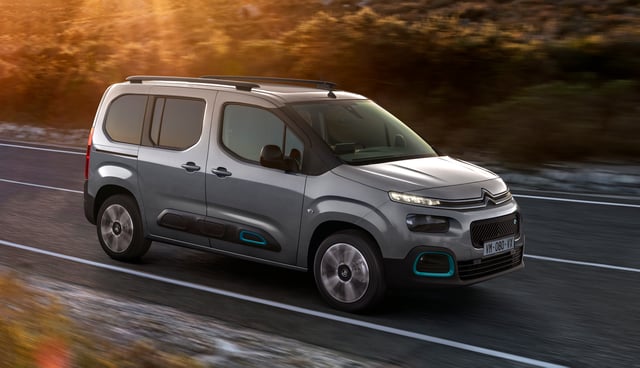
The smallest in Citroën’s line of electric vans, the e-Berlingo, is a flexible, versatile vehicle. Unlike its predecessors, the Citroën e-Berlingo was designed from the ground up as an EV, which means it retains the same carrying capacity as its diesel counterpart. Amongst all the LCVs on our list, it charges the fastest and has one of the longest ranges making it well-suited for heavier daily use.
Citroën e-Berlingo specifications
The Citroën e-Berlingo is available in two models, the five-seater e-Berlingo M with a maximum payload of 626 kg and the longer seven-seater e-Berlingo XL with a maximum payload of 639 kg, both with a 50 kWh battery capacity.
- e-Berlingo M has a range of up to 177 miles
- e-Berlingo XL has a range of up to 173 miles
The starting price of the Citroën e-Berlingo is between £30,995 and £31,995* depending on the model and trim level.
*The prices were taken at the time of writing from Citroen UK.
How long does it take to charge a Citroën e-Berlingo?
The time it takes to charge a Citroën e-Berlingo varies based on the power output and type of charger. We’ve calculated the charging time with the most common charging outputs at each charging level.
| Charging level | Charging output |
Charging times* |
| Level 1 (AC) | 2.3 kW | 23h54m |
| Level 2 (AC) | 7.4 kW | 07h25m |
| Level 2 (AC) | 11 kW | 5h00m |
| Level 2 (AC) | 22 kW | 2h30m |
| Level 3 (DC) | 50 kW | 40 min |
| Level 3 (DC) | 100 kW | 20 min |
*These numbers provide a calculated estimation of charging times – from 0 to 100 percent (AC) and 20 to 80 (DC) percent state of charge (SOC) – and do not reflect actual charging times or real-life situations. For a more accurate representation of (or more information on) actual charging times, please refer to the original manufacturer or certified dealerships. The results are based on an equation that uses the standard battery size and average performance of charging stations as metrics and are rounded up for readability. The highest DC charging power is the maximum power supported by the vehicle.
Peugeot e-Partner
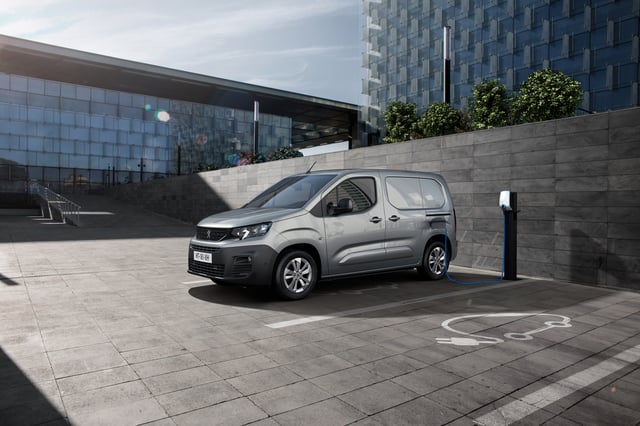
Sharing many parts with the Citroën e-Berlingo, the Peugeot e-Partner is similarly priced and specced, with a similar range and payload capacity. Like the Citroën, it supports a decent fast charging speed, and a range of AC charging outputs making it a reliable and versatile choice for longer trips.
Peugeot e-Partner specifications
The Peugeot e-Partner comes available in three different models, the e-Partner Panel Standard with a maximum payload of 803 kg, the e-Partner Panel Long with a maximum payload of 751 kg, and the e-Partner Crew Long with a maximum payload of 721 kg.
Each model of the Peugeot e-Partner has a 50 kWh battery capacity which provides a claimed range of 171 miles. The starting price of the Peugeot e-Partner is between £36,402 and £39,156* depending on the model and trim level.
*The prices were taken at the time of writing from Peugeot UK.
How long does it take to charge the Peugeot e-Partner?
The time it takes to charge a Peugeot e-Partner varies based on the power output and type of charger. We’ve calculated the charging time with the most common charging outputs at each charging level.
|
Charging level
|
Charging output
|
Charging times*
|
|
Level 1 (AC)
|
2.3 kW
|
23h54m
|
|
Level 2 (AC)
|
7.4 kW
|
7h25m
|
|
Level 2 (AC)
|
11 kW
|
5h00m
|
|
Level 3 (DC)
|
50 kW
|
40 min
|
|
Level 3 (DC)
|
100 kW
|
20 min
|
*These numbers provide a calculated estimation of charging times – from 0 to 100 percent (AC) and 20 to 80 (DC) percent state of charge (SOC) – and do not reflect actual charging times or real-life situations. For a more accurate representation of (or more information on) actual charging times, please refer to the original manufacturer or certified dealerships. The results are based on an equation that uses the standard battery size and average performance of charging stations as metrics and are rounded up for readability. The highest DC charging power is the maximum power supported by the vehicle.
Fiat E-Ducato
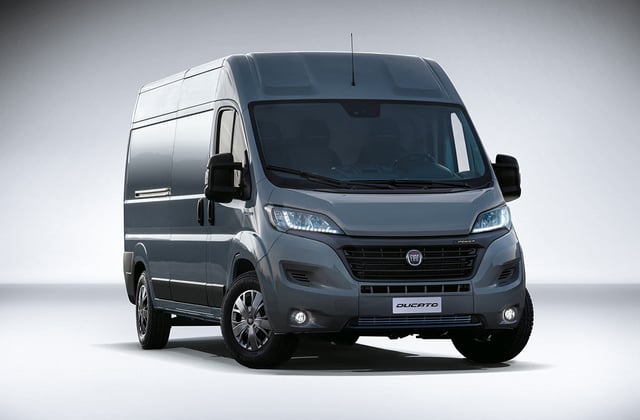
In the large van market, the Fiat E-Ducato offers a highly versatile package with a range of heights, lengths and chassis available for a total of 24 possible combinations. Its two battery sizes provide a practical range, which can easily be topped up in under an hour with fast charging, making the E-Ducato well-suited for all-day use.
Fiat E-Ducato specifications
The Fiat E-Ducato is available in multiple different heights, lengths and wheelbases, providing up to 1855 kg. All versions can be configured with two battery capacities both providing a different range.
- E-Ducato 47 kWh: provides a range of up to 146 miles
- E-Ducato 79 kWh: provides a range of up to 230 miles
The starting price of the E-Ducato is between £67,950 and £82,950* depending on the model variation and trim level.
*The prices were taken at the time of writing from Fiat UK.
How long does it take to charge a Fiat E-Ducato?
The time it takes to charge a Fiat E-Ducato varies based on the power output and type of charger. We’ve calculated the charging time with the most common charging outputs at each charging level.
| Charging level | Charging output |
Charging times*:
49 kWh
|
Charging times*:
79 kWh
|
| Level 1 (AC) | 2.3 kW | 23h26m | 37h46m |
| Level 2 (AC) | 7 kW | 7h42m | 12h24m |
| Level 2 (AC) | 11 kW | 4h53m | 7h54m |
| Level 2(AC) | 22 kW | 2h26m | 3h57m |
| Level 3 (DC) | 50 kW | 39 min | 1h03m |
*These numbers provide a calculated estimation of charging times – from 0 to 100 percent (AC) and 20 to 80 (DC) percent state of charge (SOC) – and do not reflect actual charging times or real-life situations. For a more accurate representation of (or more information on) actual charging times, please refer to the original manufacturer or certified dealerships. The results are based on an equation that uses the standard battery size and average performance of charging stations as metrics and are rounded up for readability. The highest DC charging power is the maximum power supported by the vehicle.
Peugeot e-boxer
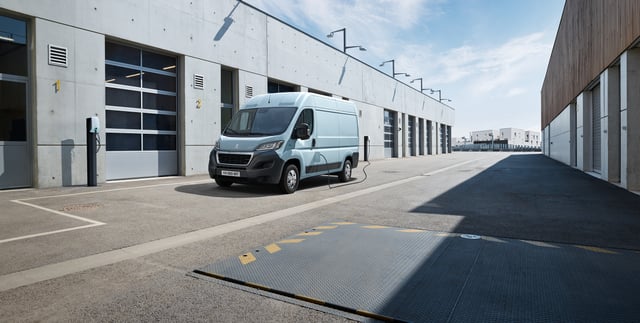
The Peugeot e-Boxer is another large electric van with a range of lengths and wheelbase lengths. Like the Fiat E-Ducato, it's available in two different battery sizes, although its range is somewhat on the lower end. Still, the distance should be enough for the majority of urban deliveries, and if needed, the e-Boxer can charge quickly using fast charging.
Peugeot e-Boxer specifications
The Peugeot e-Boxer is available in multiple different lengths providing a maximum payload of up to 1,100 kg, and a choice of two different battery sizes with different ranges.
- e-Boxer 37 kWh: provides a range of up to 73 miles
- e-Boxer 75 kWh: provides a range of up to 154 miles
The starting price of the Peugeot e-Boxer is between £67,542 and £81,516* depending on the model variation and trim level.
*The prices were taken at the time of writing from Peugeot UK.
How long does a Peugeot e-Boxer take to charge?
The time it takes to charge a Peugeot e-Boxer varies based on the power output and type of charger. We’ve calculated the charging time with the most common charging outputs at each charging level.
| Charging level | Charging output |
Charging times*:
37 kWh
|
Charging times*:
70 kWh
|
| Level 1 (AC) | 2.3 kW | 17h41m | 33h28m |
| Level 2 (AC) | 7.4 kW | 5h30m | 10h24m |
| Level 2 (AC) | 22 kW | 1h51m | 3h30m |
| Level 3 (DC) | 50 kW | 29 min | 56 min |
*These numbers provide a calculated estimation of charging times – from 0 to 100 percent (AC) and 20 to 80 (DC) percent state of charge (SOC) – and do not reflect actual charging times or real-life situations. For a more accurate representation of (or more information on) actual charging times, please refer to the original manufacturer or certified dealerships. The results are based on an equation that uses the standard battery size and average performance of charging stations as metrics and are rounded up for readability. The highest DC charging power is the maximum power supported by the vehicle.
Mercedes eSprinter
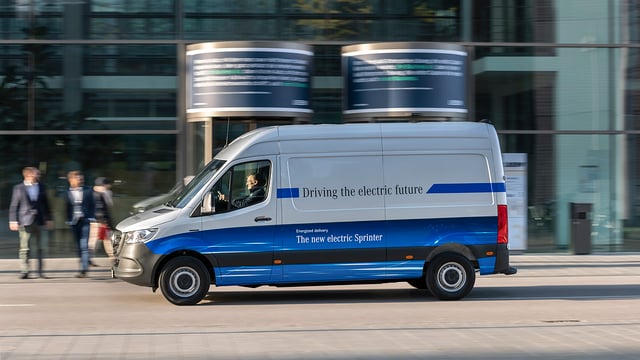
This year, Mercedes is updating its three-year-old Sprinter with a newer, much more capable, purpose-built EV. Depending on the battery capacity, the Mercedes eSprinter can carry between 846 and 1,149 kg payload, with 11 m3 of space. While its standard charging tops out at 20 kW, the eSprinter can be configured with up to 80 kW charging for added versatility.
Mercedes-Benz eSprinter specifications
The Mercedes eSprinter comes with a 47 kWh usable battery capacity, which provides a range of up to 109 miles, and the starting price of the eSprinter is £32,293* for an approved used.
*The prices were taken at the time of writing from Mercedes-Benz UK.
How long does a Mercedes eSprinter take to charge?
The time it takes to charge a Mercedes-Benz eSprinter varies based on the power output and type of charger. We’ve calculated the charging time with the most common charging outputs at each charging level.
|
Charging level
|
Charging output
|
Charging times*:
35 kWh
|
Charging times*:
47 kWh
|
| Level 1 (AC) | 2.3 kW | 16h44m | 22h28m |
| Level 2 (AC) | 7.4 kW | 5h12m | 6h59m |
| Level 3 (DC) | 20 kW | 1h10m | 1h34m |
| Level 3 (DC) | 50 kW | 28 min | 37 min |
| Level 3 (DC) | 80 kW | 17 min | 23 min |
*These numbers provide a calculated estimation of charging times – from 0 to 100 percent (AC) and 20 to 80 (DC) percent state of charge (SOC) – and do not reflect actual charging times or real-life situations. For a more accurate representation of (or more information on) actual charging times, please refer to the original manufacturer or certified dealerships. The results are based on an equation that uses the standard battery size and average performance of charging stations as metrics and are rounded up for readability. The highest DC charging power is the maximum power supported by the vehicle.
Renault Master e-tech
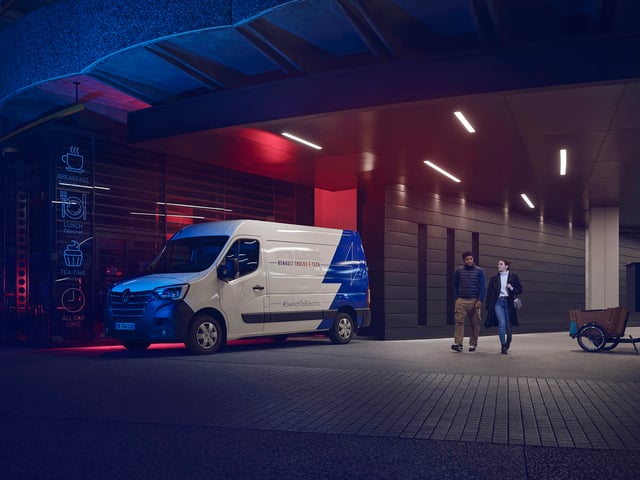
A third option in the family of large vans is the Renault Master E-Tech, based on the company’s reliable diesel version of the Master. Whilst its 33 kWh battery and up to 75 mile actual range seems low, it boasts one of the largest carrying capacities of any electric van on the list. At up to 1,300 kg and 13 m3, it supports a generous payload that makes the E-Tech a compelling choice of last-mile delivery.
Renault Master E-Tech specifications
The Renault Master E-Tech is available in three lengths (Short, Medium, Long) and two heights (Low and Medium). All models come with a 33 kWh battery and 75 mile actual range. The starting price for the Renault Master e-tech is £53,080* depending on the model variation and trim level.
*The prices were taken at the time of writing from Renault UK.
How long does a Renault Master E-Tech take to charge?
The time it takes to charge a Renault Master e-tech varies based on the power output and type of charger. We’ve calculated the charging time with the most common charging outputs at each charging level.
|
Charging level
|
Charging output
|
Charging times*
|
|
Level 1 (AC)
|
2.3 kW
|
15h46m
|
|
Level 2 (AC)
|
7.4 kW
|
4h25m
|
*These numbers provide a calculated estimation of charging times – from 0 to 100 percent (AC) and 20 to 80 (DC) percent state of charge (SOC) – and do not reflect actual charging times or real-life situations. For a more accurate representation of (or more information on) actual charging times, please refer to the original manufacturer or certified dealerships. The results are based on an equation that uses the standard battery size and average performance of charging stations as metrics and are rounded up for readability. The highest DC charging power is the maximum power supported by the vehicle.
Mercedes eVito
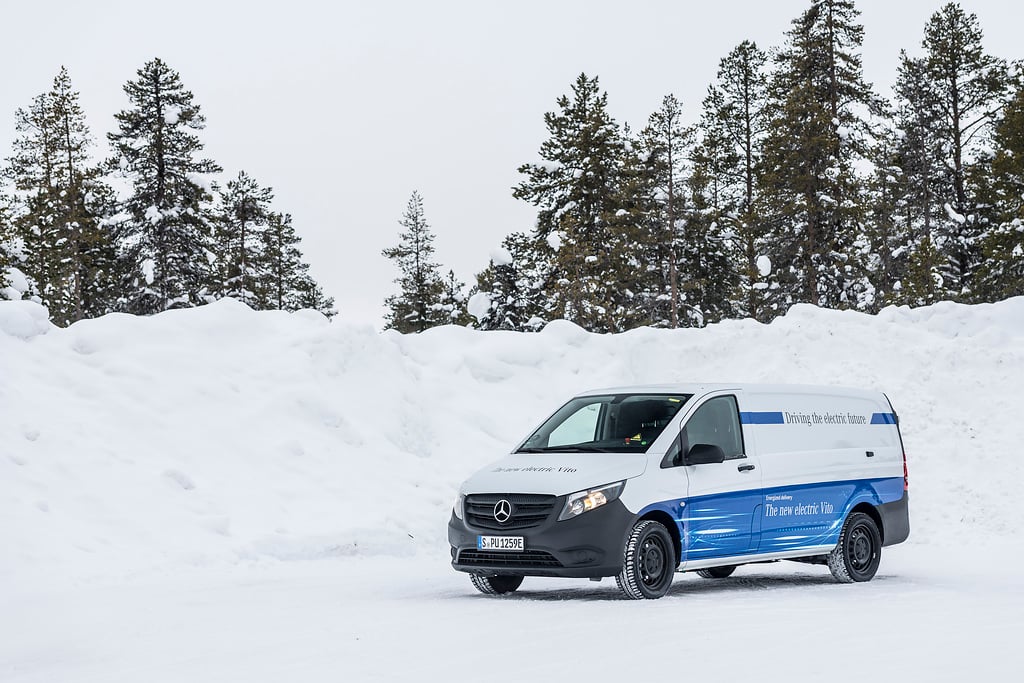
Like the eSprinter, Mercedes is also updating the eVito this year. It’s receiving an impressive battery and performance upgrade, with a new 60 kWh capacity and a much-improved range. The eVito also retains its predecessor’s practicality, with up to 6.6 m3 carrying capacity that exceeds most other small electric vans.
Mercedes eVito specifications
All Mercedes eVito models feature a 60 kWh battery with a range of 162 mile combined WLTP range. They can be configured with a Long or Extra-Long wheelbase, with a payload capacity of 6.0 m3 and 6.6 m3 respectively. The starting price for the Mercedes eVito is £52,320* depending on the model variation and trim level.
*The prices were taken at the time of writing from Mercedes UK.
How long does a Mercedes eVito take to charge?
The time it takes to charge a Mercedes eVito varies based on the power output and type of charger. We’ve calculated the charging time with the most common charging outputs at each charging level.
|
Charging level
|
Charging output
|
Charging times*
|
|
Level 1 (AC)
|
2.3 kW | 28h41m |
| Level 2 (AC) | 7.4 kW | 8h55m |
|
Level 2 (AC)
|
11 kW | 6h00m |
|
Level 3 (DC)
|
50 kW | 48 min |
|
Level 3 (DC)
|
80 kW | 30 min |
*These numbers provide a calculated estimation of charging times – from 0 to 100 percent (AC) and 20 to 80 (DC) percent state of charge (SOC) – and do not reflect actual charging times or real-life situations. For a more accurate representation of (or more information on) actual charging times, please refer to the original manufacturer or certified dealerships. The results are based on an equation that uses the standard battery size and average performance of charging stations as metrics and are rounded up for readability. The highest DC charging power is the maximum power supported by the vehicle.
Far from a time when electric vans were just a retrofit of their diesel-powered versions, manufacturers today are offering dozens of capable, cost-efficient electric light commercial vehicles. We hope this article has provided an overview of some of the main ones for this year and given you an idea of their different charging possibilities.
Related articles
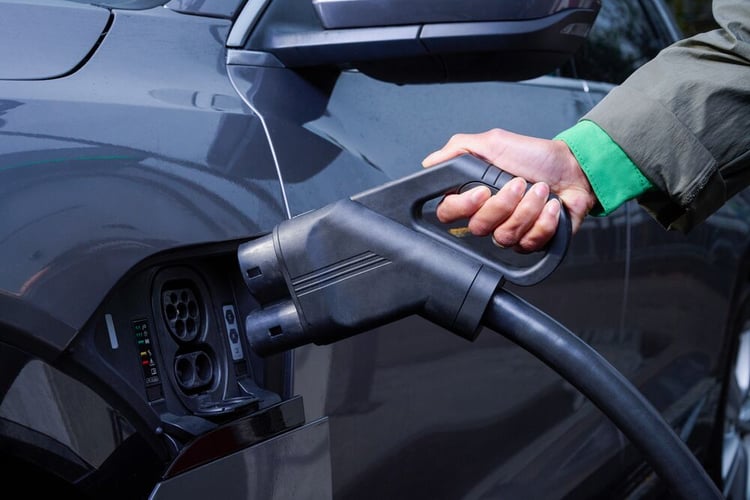
Is DC fast charging bad for your EV battery?
While there is research that shows that frequent rapid (DC) charging can somewhat degrade the battery quicker than AC...

5 things you didn't know about EV batteries
There’s little doubt that electric mobility is the future. Electric vehicle (EV) sales have skyrocketed in the past few...

Electric car battery weight explained
How much an electric vehicle (EV) battery weighs depends greatly on the vehicle and model. On average, however, EV...